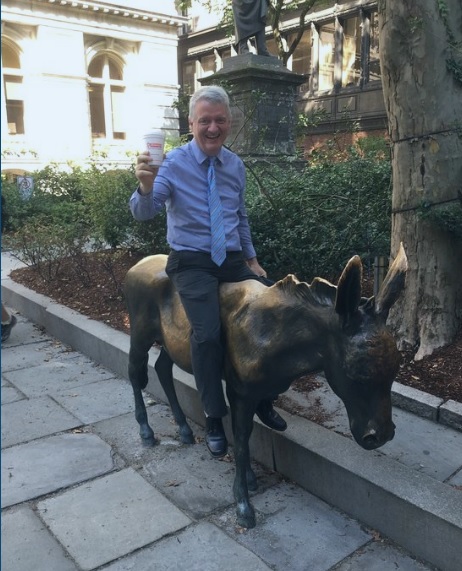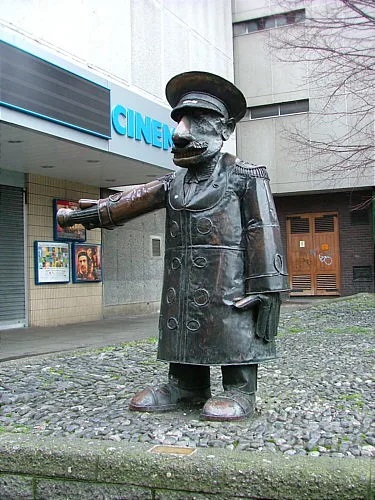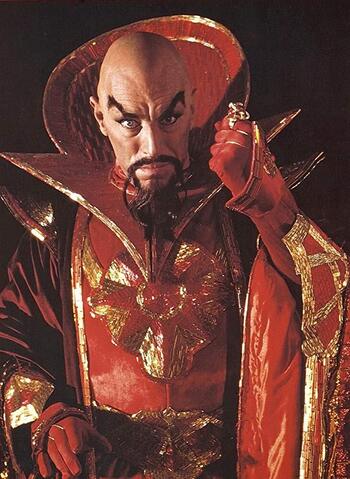That's a jibe at your ex-Taoiseach Albert Reynolds who made his money on the Irish ballroom scene, the same scene Adam Clayton of U2 recently published a documentary about.
The ballroom scene in Ireland was generally a curiously culchie affair but also a very popular craze in the cities: culchies from up and down the counties would arrive by bus to these big old ballrooms (often mostly town halls bedecked in green, white, and orange bunting and a few semi-deflated balloons) from miles around to see and hear the show-bands doing their versions of contemporary international hits of the day. The players would listen in on radio Luxembourg and the BBC while in the van heading to the next gig or buy the records (if they could) to copy the chords and lyrics in order to draw up reference sheet music for the players when they played it live for the first time that same night. These were ad hoc professional bands who foraged a decent living for themselves which were (initially) overlooked by the tax man. There was a certain Irish-styled 'glamour' about the blokes in the bands who were, for all intents and purposes, the curiously Irish sex symbols of the day: bad suits, massive side-burns, mops of greased up hair, and some terrible dance moves.
In time, the taxman became aware that these popular show-bands were making big and untraceable amounts of cash/punt money, as were the promoters who booked the bands and sold the tickets for the venue: and in turn the venues too made their cut on pints at the bar (if there was a bar, often there wasn't so a bottle of something strong in his inside pocket/her handbag was the only alternative). Albert Reynolds was one of the midlands bigger promoters in his time, and of course there are lots of rumours about him skying away large amounts of cash money in the walls of his house as well as the back garden to keep it from the taxman. Singers like the recently deceased Dickie Rock made their money on those circuits, and in time, out on the English scene too, mainly playing for the Irish ex-pats and emigrants up and down the country. The Miami Showband were another massive success on the national and international circuit but then they were stopped one night just outside the border after a gig on the way home to Dublin in their van and northern loyalists riddled most of them to death on the roadside. One played dead and managed to survive it. A terrible and entirely unnecessary tragedy.
So the scene wasn't without its controversies, and therefore also the sleaze element attached as to how the cash money was handled and laundered so that the players weren't getting lashed by John Q Taxman any more than the promoter was. In reality, it was a free for all. Cash money all over the place. All the lads on one side of the hall, all the girls on the other. They needed to lubricate their nerves before approaching a girl to ask for a dance, so one half of the room was all lads standing staring, sucking out of pint glasses and smoking like chimneys. On the opposite side of the hall the girls placed their handbags in a neat pile on the floor and danced around them, practicing their latest moves and showing off their new dress/shoes/hairstyles. When the lads were suitably oiled, the fun began.
Bands in cheesy matching suits, polished patent leather shoes, bell-bottom pants and striped socks, plus the Grecian Formula 2000 to straighten out those ginger curls were set off by the smell of carbolic soap from the toilets where the players freshened up and changed into their stage-wear. They had to compete with the petrol that was used to wash down the wooden floors before the show so that the shoes worn when dancing slid across it instead of into it. Not too many drugs were being used that we know of, but there were lots of things available that they might well have been using: like pharmaceutical methamphetamine, or speed - normally used for weight loss. A dodgy chemist or a fake prescription and you're sorted.
Religion and the church held sway over these wicked nights out for the heathen, and there was lots of controversy across the years involving all sorts of people. On one particularly hilarious occasion, an American star (can't think of her name) was booked to play a hall in Kerry one night. The show was advertised publicly and on the radio and it totally sold out. When the local bishop saw the posters he balked. She was a buxom blond who used her mammary talents to hypnotize the men and the tickets sold out pronto: her gig was part singing, part story-telling, and lots of boob action. The bishop decided to go hell for leather at Sunday mass condemning anyone planning to go as sinners who would NOT be welcome back into his church the following Sunday. Then he showed up at the venue on the night with a few placards and a few henchmen and they prayed at the front gates while eyeballing those with enough nerve to walk past them. Few crossed the prayer line. The show was pulled at the last minute and she had her money regardless, the promoter had to take the hit. From there it later transmogrified into your classic 'down with this sort of thing' scene on Father Ted with the pair of them handcuffed to a bollard outside a cinema showing 'The Passion Of Saint Tibulus'.
Even Dublin city had the same type of ballroom dances, mostly for the culchies working and living in the city. Up around Parnell Street there are a few historic buildings which were the dance halls of the day. The bands called it 'The Rubber Chicken Circuit' because the price of the ticket in included a chicken and spuds dinner. Then there was the London scene, lots of Paddy and Bridie types there as well as all of the northern industrial towns, all packed full of ex-pat Irish workers. Getting your cut in sterling presented a few problems, but one cheap way to wash the money was to give it to someone like Reynolds and he'd return your cash in punts - for a small fee. Every avenue of revenue was exploited to the max, and there were all sorts of cunts lining up trying to muscle in on the scene. It continued like that out of the 1950s and into the 1970s before modern nightclubs were beginning to appear.
Not a very glamourous scene by any means, and to illustrate it there was a classic BBC TV mini-series called 'The Country Girls' which showed the more innocent and religiously confused youth of the day trying to get their heads around this modern and fast moving world. An Irish ballroom mini-series was made and shown on RTE called 'The Ballroom Of Romance' which was a classic in its time. While 'The Country Girls' was focused on things like getting your first period, meeting boys for dates, kissing techniques, hand-jobs too, and avoiding getting pregnant. Knowing how pregnancy occurred at all was another one, the other focused more on the social straits of the time. The constraints Irish women lived under while the men were mostly alcoholics who worked on the farms for a pittance but still hoped to find a decent wife. The sleaze of the time was best illustrated toward the end of the film where the drunk bloke keeps asking the sober girl to come into the bushes with him. She has high hopes for her future, but her feet are stuck in the mud, so she goes into the bushes with him anyway.
The grim and miserable conditions of the Ireland of the time were palpable: cold, damp, wet, rainy, shivering, collars pulled up high, shoulders to the wind.
In time things improved a bit, but even in my own experiences not much has changed: I had a client out in Dunshaughlin who owned a very popular roadside bar (with a massive hall attached) and lounge called The County Club. They did dinner for farmers in the daytime - a full-on carvery offering the staples every farmer (like Val) wants: potatoes, a few chops, garden peas, gravy, etc. Not a seat free in the house, all of them mouth breathing and shoveling the food down like savages. Then as evening wore in, things quietened down. On the weekends she had club nights in the huge hall (it was fucking freezing in there) and even though the bar was in the middle of fucking nowhere, busloads of punters showed up in coaches from miles all around. Half an hour later the place would be packed to the gills and the heat and stink of cheap perfume and aftershave unbearable. All the lads lining the bar. All the girls dancing around their handbags, waiting for the blokes to get langered enough to grow some balls and ask them for a dance and a shift.
Not much changes in Ireland, even as the decades roll over each other in a desperate bid to enlighten and free themselves from the shackles they were born into. It's just as fucked up today as it was seventy years ago. Fifty years ago. The Ireland of no sex. No contraception. No porn. No naughty books with naughty words and themes. Church every Sunday without fail. A few coppers into the begging bowl to pay down on your sins. I worked for Albert Reynold's grandson John, who owned and ran a club called The POD (Place Of Dance) and soon after, The Chocolate Bar. We were booked in to play along with the DJ of the night on all sorts of drums and percussions. The place was always packed tight full of punters and Reynolds was making big money in the same way his Grandad did: cash at the door to get in, cash at the bar to get drunk. Eight hundred punters in and a long queue outside was already stupid money. Factor in the bar sales and you're knee deep in the notes. We did three sets: each one was (a) play along with the DJ for five songs, then he fades and we go up, the drums being the only thing your hear. Then (b) after a three minute breakbeat, we fade and the DJ comes up. Three or four of those mini sets and we're done for the night. Excellent cash money into the hand.
In reality, they couldn't sell drink on promotional club nights unless there was a stage performance included in the bill. Standard rules. The same applied at The Ormond Multimedia Centre: no live act - no drink license. So we were in the right place at the right time. All of the emerging clubs booked us for exactly the reasons described, but also for another vital factor: keeping seven hundred gurning punters whacked up on coke, speed, and MDMA off the stage and out of the DJ's face. Having twenty punters on the stage tended to send the needle on the decks whizzing across the wax you're mixing. We were there to form a barrier that kept them off and helped too with getting a license from the fire inspector who had the final say in what was allowed and what wasn't. I got to meet and play with all the big names of the late 1980s and most of the 1990s. David Holmes, Fatboy Slim, Carl Cox, Andy Weatherall, Pete Tong, Norman Jay, A Guy Called Gerald, Grooverider, LTJ Bukem, and loads more. They liked the idea of the drummers doing break-beats because they could take a break and have a sniff or a wee-wee while we riled up their crowd. Money for nothing, really. But they were great nights, and we made more money doing those gigs than we did taking a four-piece (or even a thirteen piece) into the Gaiety and Olympia theatres for their weekend club nights.
What you see of happening club nights these days isn't a million miles away from the reality of the ballroom days. The basic model hasn't changed a bit: get the right name, the biggest venue, scalp the punters, give them exactly what they want, and fleece them while you have them captive. And they come from miles around to pack the place out. Your modern Irish culchies aren't much different even if the city folk are. They still do exactly the same thing today: just look at dumps like Copperfaced Jacks: still packed out with culchie nurses and coppers, all looking for the ride, the ware, hand-job, and a feed of fish and chips before bed.
The Irish were never very sophisticated, they're not today either. Dublin in the 1990s was banging, I played for other promoters and I ran my own club nights with partners. We had Dublin's first ever drum&bass nights in The DA Club: packed out every time, so we moved to The POD and had more punters and more space to add things in, like drumming troupes and percussionists, toasters and rappers doing guest spots. You name it. We called it 'Moist' and it sure as shit was on the dance floor: sweaty and heady, so I'd flood the floor with dry ice up to the knees. Great fun, great nights, loads of happy feet, and a nice wedge in cash dollar money.
I'm looking forward to seeing Clayton's documentary: he did some great interviews about his research into the legendary ballroom days and he has money enough to make the production appealing internationally as well as locally. It's great that he's sober too: I visited his house out in Rathfarnham a few times. First time was a blast seeing his fridges off the kitchen side: each one had the brand and logo on the front door and inside was packed tight with bottles. Beers, ales, champagnes, white wines, you name it. Now he's tea-total. But I'd imagine he still has a supply of everything you might like as a guest in his home.
Here's a Finnish lyric version of the Joe Dolan classic 'You're Such A Good-Looking Woman' (Hammond/Hazlewood) which I had to get the boys to learn for a few shows which asked for it. This one's by Markku Aro, a legendary Finnish dance-hall performer still packing out the dancehalls across the country up here in Finland. The Finnish have their own version of The Ballrooms Of Romance, but they're nothing like the Irish version.



